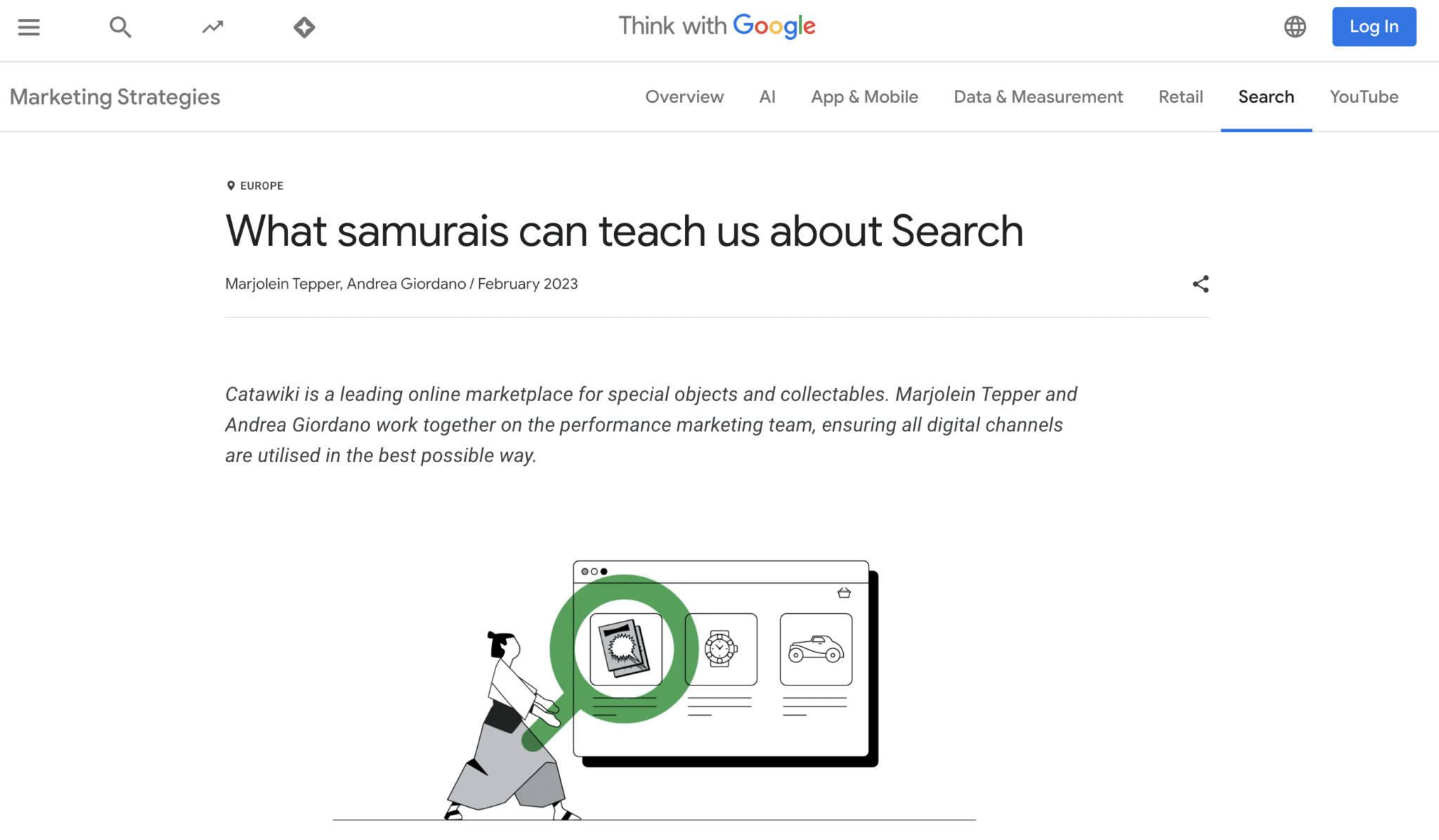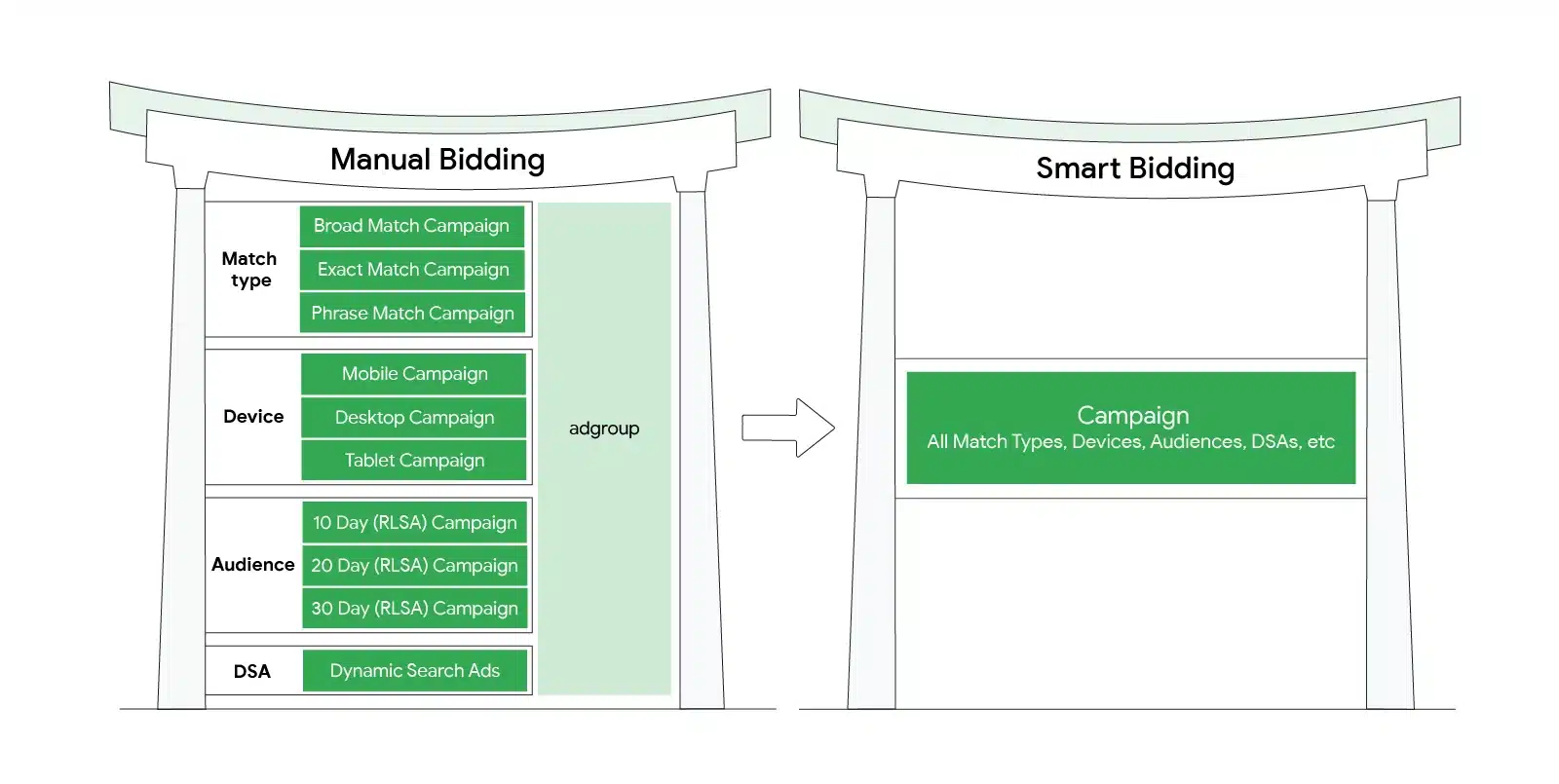Google Ads has changed significantly, adjusting to the latest technologies and users’ evolving online behavior. Previously, advertisers had to manage campaigns closely. Now, there’s a bigger focus on using data and automation.
This has led to the introduction of the Hagakure method, a new approach that simplifies Google Ads management, encourages using broad match options and takes advantage of Google’s automation tools.
Here’s what Hagakure means for Google Ads advertisers and how it can help you manage your paid search campaigns.
The origins of Hagakure
“Hagakure” comes from an 18th-century Japanese book about samurai teachings written by Yamamoto Tsunetomo. It emphasized values like loyalty and purpose. The word means “hidden by the leaves,” suggesting deep wisdom in plain sight.
Connecting this to digital advertising, the Hagakure method in Google Ads is about finding a clear and simple way to advertise successfully, much like how samurais sought clarity in their actions.
This approach aims to simplify digital advertising, capturing the clear purpose that samurais valued.

Single keyword ad groups (SKAG) and single-themed ad groups (STAG) are foundational structures in search ads.
- SKAG focuses on crafting individualized ads for every keyword, offering precision and potentially improved Quality Scores.
- STAG, on the other hand, clusters related keywords under one theme, providing a balance between detail and ease of management.
In contrast, Hagakure emphasizes automation and scale, capitalizing on Google’s machine learning.
While SKAG and STAG prioritize manual management and/or more control, Hagakure harnesses automation and Smart Bidding technologies for on-the-fly optimizations.
Moreover, Hagakure promotes simplicity by reducing the number of entities like ad groups and campaigns, making it easier to handle as accounts expand.

Importantly, Hagakure isn’t exclusive; advertisers can blend it with SKAG or STAG techniques, enabling a tailored approach that leverages granularity and automation.
Audience attribution automation (AAA) and “modern search” were once related buzzwords for a simpler account structure. Just as Hagakure seeks to cut through the complexities:
- AAA was about precisely targeting audiences with automation.
- Modern search aimed to bring clarity and focus to search strategies by directly addressing user intent.
However, in recent times, the term Hagakure has taken center stage in Google’s communications, becoming the more mainstream term.
While modern search remains relevant, Hagakure has become the dominant narrative, emphasizing a clear and straightforward approach in the evolving digital advertising landscape.
Core principles of the Hagakure strategy
Hagakure confronts two key messages.
- Oversegmentation blocks machine learning.
- Data sets must be compact and concentrated for smart bidding to work at maximum.
The Hagakure method suggests a simpler account setup by merging similar themes and removing extra ad groups. This enables:
- Better campaign management.
- Quick adjustments to market shifts.
- Smarter resource use.
In short, organized simplicity is key.
Hagakure is necessary because accounts have become too messy. Marketers tried to control every little detail and ended up with too many campaigns, ad groups and keywords.
Instead of keeping data together, data silos existed, which made it quite hard for automated bidding strategies and automation in general to work well.
Rather than narrow, hyper-specific targeting, Hagakure uses broad match types and automation, ensuring a wider yet relevant audience is reached.
Google's Smart Bidding, empowered by machine learning, adjusts bids based on real-time audience behaviors, directing resources towards high-conversion segments.
The strategy dynamically interacts with audiences, letting algorithms set the optimal bid for each auction based on various influencing factors. Merging audience insights with automation, Hagakure reduces manual tasks. Advertisers don't constantly adjust bids; the system automates it for efficiency.
One of the most common misconceptions surrounding the Hagakure approach is the notion of broad match.
While Google often recommends using broad match, it's essential to recognize that it's not a mandatory component. The suitability of broad match varies depending on individual campaign objectives and nuances.
Hence, marketers should feel empowered to experiment with the Hagakure method with or without this match type. Tailoring your strategy to the unique situation is vital for its effectiveness.
Potential drawbacks and considerations when implementing Hagakure
Adopting the Hagakure method can be a big change for advertisers used to traditional setups. It's about changing the campaign structure and adapting to a new mindset. Those used to detailed campaign management might find the initial shift challenging.
A common worry with the Hagakure method is feeling a loss of control. Combining ad groups and using more automation can make advertisers feel they're less hands-on. While the method emphasizes simplicity, it's crucial not to lose sight of campaign details.
Using broad match can extend reach, but it has risks. Without careful monitoring, ads might appear for unrelated searches, wasting money and potentially misrepresenting the brand.
Despite Hagakure's emphasis on simplification, advertisers must regularly check and refine their broad match strategies using negative keywords.
Case study: Scaling search ads with Hagakure
There is no better way to showcase the potential of Hagakure than talking about a real case study. One of my biggest clients so far, a shoe retailer with over a thousand brands and almost a million SKUs live, is the perfect example.
After beginning our collaboration, shopping contributed to about 90% of the revenue, prompting us to devise a search strategy. Over three years, the search setup grew, and by early 2019, we were managing:
- 555 campaigns.
- 56,673 ad groups.
- 86,290 ads.
- 190,159 keywords.
Though this expansion increased search revenue, the account became too huge and difficult to manage. While popular, the prevalent structures, SKAG and STAG, weren't scalable. This setup also introduced several challenges.
Even with the expansive setup, sales either remained stagnant or saw slow growth, especially when factoring in the vast inventory. Managing over 500 search campaigns became an overwhelming task.
Most revenue growth came from adding new search campaigns tied to new brands or product lines in the inventory. Additionally, the setup struggled to adjust to varying product availability and changing seasonal items.
Despite initial challenges, we tapped into a modern search approach, which catalyzed a remarkable 300% search growth using the existing setup.
By October, our year-over-year search campaign revenue jumped from €180,000 to over €480,000.
The impressive part? We achieved this with the same brands, products, keywords and ad assets.
- The key change was refining account structures to unleash the potential of Smart Bidding fully.
- We streamlined the process by consolidating several detailed campaigns into one concise campaign. What used to be individual campaigns were transformed into ad groups.
- Only high-converting brands were retained. The number of campaigns for fashion brands was drastically reduced from 450 down to just three.
- We grouped the top eight brands, which made up about 75% of search sales, into a single top-tier campaign. Each main keyword had its own dedicated ad group.
Additionally, to serve as a backup and discover new keyword opportunities, we established a Dynamic Search Ads (DSA) ad group for every brand.
However, it's crucial to employ a negative keyword strategy to prevent the DSA from overlapping with or "stealing" traffic from your keyword-focused ad groups.
So instead of having 450 data silos working for themselves, we streamlined all important entities into three campaigns, supercharging the smart bidding capabilities and ultimately leading to a foundation for stable growth.
And this is what Hagakure is all about – maximizing results with minimum entities. It’s comparable to the Pareto principle, where 80% of the results are achieved with 20% of the resources.
Practical implementation tips
To check your account's eligibility for this approach, I highly recommend running this script from Google to check the current account structure.
Although a single script might not be enough to take care of individual cases, it's an excellent tool for high-level reporting on campaign, ad group and keyword data to see if there’s potential in restructuring the account.
Choose your keywords
If you struggle to pick the right keywords for your new setup, follow this approach:
- Pick your top campaigns you want to transform into a modern search.
- Run the search query report for the last 30/60/90 days and filter for search queries with >1 conversion.
- Run the keyword overview report for 30/60/90 days and filter for keywords with >1 conversion.
- Join those two reports and identify the terms that bring in conversions. Eliminate the rest.
- To protect you from seasonality, it is recommended to check the reports again for the last 3/6/9 and 12 months.
- Try to limit your keyword set to a maximum of 20 keywords per ad group.
Succeed with top responsive search ads
Use this framework if you see issues getting enough assets into the campaigns. Try to make use of keyword insertion and ad adjustments.
Use the native Google Ads tag for conversion tracking
Avoid imported conversions from Google Analytics 4 or other third-party tools when you can.
The native Google Ads tag is the quickest for data transfer to the ads account, while other methods can cause delays.
Adjust your attribution model
Set attribution to data-driven and keep the conversion window at 90 days. Ensure Enhanced Conversions are on.
Streamline audiences
Pick audiences that fit the purchase cycle and try to avoid duplicates and too many overlaps. You don’t want to clog your campaigns with hundreds of audiences.
Track your performance
Do proper reporting after implementation. Make sure to count in the conversion delay and learning period.
The post The Hagakure method for Google Ads management appeared first on Search Engine Land.
from Search Engine Land https://ift.tt/z8DCokX
via https://ift.tt/siUwRCp https://ift.tt/z8DCokX



No comments:
Post a Comment